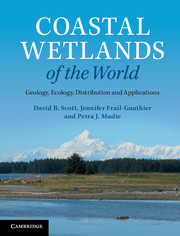Book contents
- Frontmatter
- Contents
- Preface
- List of acronyms and abbreviations
- 1 Introduction: what is covered in this coastal wetlands book?
- 2 Physical aspects: geological, oceanic and climatic conditions
- 3 Zonations and plants: development, stressors and adaptations
- 4 Animals in coastal wetlands: zonation, adaptations and energy flow
- 5 Human intervention causing coastal problems
- 6 Coastal wetlands worldwide: climatic zonation, ecosystems and biogeography
- 7 Examples of North American salt marshes and coastal wetlands
- 8 Examples of South American coastal wetlands
- 9 Africa: selected marsh and mangrove areas
- 10 Europe and Asia: a view of what remains
- 11 Australasia: wetlands of Australia and New Zealand
- 12 Applications in geological monitoring: paleoseismology and paleoclimatology
- 13 Applications in conservation of plant biodiversity and agriculture
- 14 Using mesocosms as a way to study coastal wetlands
- 15 Conclusions and future directions
- References
- Index
- Plate section
8 - Examples of South American coastal wetlands
Published online by Cambridge University Press: 05 July 2014
- Frontmatter
- Contents
- Preface
- List of acronyms and abbreviations
- 1 Introduction: what is covered in this coastal wetlands book?
- 2 Physical aspects: geological, oceanic and climatic conditions
- 3 Zonations and plants: development, stressors and adaptations
- 4 Animals in coastal wetlands: zonation, adaptations and energy flow
- 5 Human intervention causing coastal problems
- 6 Coastal wetlands worldwide: climatic zonation, ecosystems and biogeography
- 7 Examples of North American salt marshes and coastal wetlands
- 8 Examples of South American coastal wetlands
- 9 Africa: selected marsh and mangrove areas
- 10 Europe and Asia: a view of what remains
- 11 Australasia: wetlands of Australia and New Zealand
- 12 Applications in geological monitoring: paleoseismology and paleoclimatology
- 13 Applications in conservation of plant biodiversity and agriculture
- 14 Using mesocosms as a way to study coastal wetlands
- 15 Conclusions and future directions
- References
- Index
- Plate section
Summary
Key points
Most South American wetlands are on the low-lying eastern shores, with few on the tectonically active Andean coast; there are some extensive mangrove forests, but many are reduced by aquaculture and pollution; indigenous mangal people and endemic biota are now endangered; tropical mangroves thrive on deltas and beach barriers of huge rivers, including the Amazon; subtropical wetlands grow in lagoons (‘gamboa’) with small ocean entrances and tidal creeks – these are permanently closed in Uruguay; the southernmost red, white and black mangroves are at 28.9° S; temperate coastal lagoons of Argentina have cordgrass and pickleweed in the intertidal zone and halophytic herbs in high marshes; temperate wetlands along the desert coast of Chile support beds of sea anemones and mussels. Subarctic wetlands are sparse because strong winds, ozone-hole irradiation and oil spills are added stressors.
As in North America, the West and East Coasts of South America are very different from a geological viewpoint, which is reflected in the Neotropical coastal wetland distributions (Figure 8.1). Tides on both coasts are semi-diurnal or mixed and mostly of medium range (2–3 m) except for macrotidal areas in the northwest, southeast and at the mouth of the Amazon River (Eisma, 1997). The West Coast, part of the ‘Pacific Ring of Fire’, is tectonically active and bordered by the high Andean mountain ranges, which restrict the amount of lowland available for spread of intertidal wetlands. Here rivers and streams are small, wave erosion is high and earthquakes followed by tsunami waves can liquefy the marsh sediments, resulting in subsidence of up to 1.6 m over large areas (e.g. 200 km in 1979). In contrast, the East Coast passive margin is formed mainly from sedimentary basins and it has extensive low-lying plains crossed by long rivers. There are large deltas at the mouths of the Orinoco, Amazon and São Francisco rivers, which supply sediment to huge mudflats (Figure 8.2). The Amazon River is the source for vast amounts of sediment that coastal currents transport to the giant mudbanks (‘slikke’) off Surinam and French Guiana.
- Type
- Chapter
- Information
- Coastal Wetlands of the WorldGeology, Ecology, Distribution and Applications, pp. 132 - 152Publisher: Cambridge University PressPrint publication year: 2014



